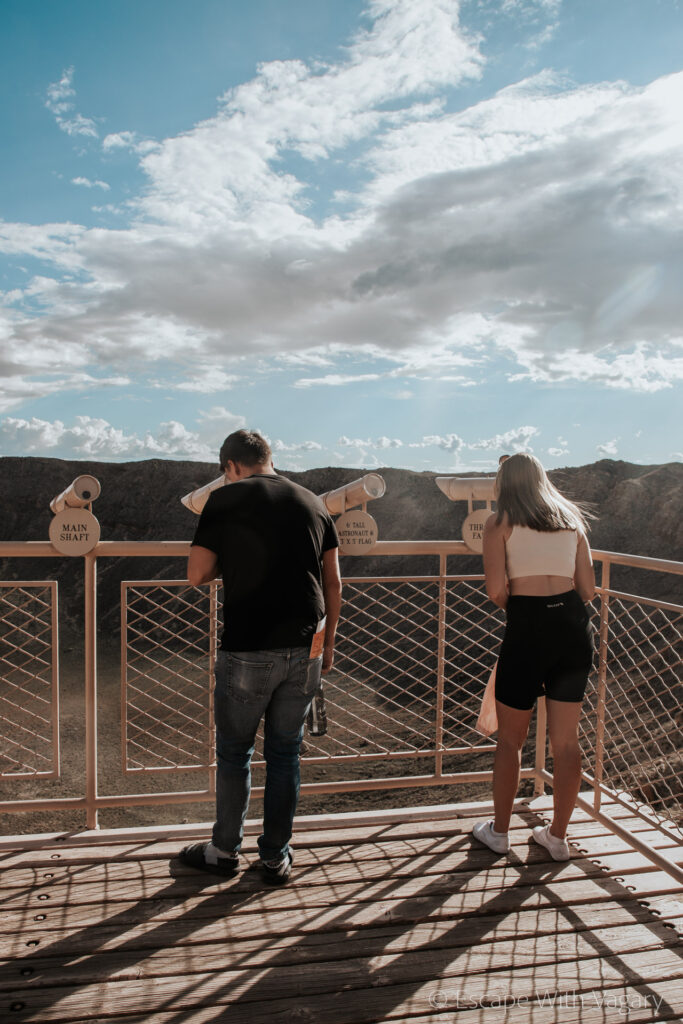


After visiting some muddy waterfalls (Grand Falls), I went to see a hole in the ground. Located about 37 miles east of Flagstaff, and 18 miles west of Winslow, sits Meteor Crater, also known as Barringer Crater.
It’s quite literally just a massive hole in the ground. My favorite part was the lookout telescopes (specifically the astronaut one) they had located on Moon Mountain, the highest Observation area.

The fixed telescopes show you little details that are invisible to the naked eye. Looking down from the deck, I couldn’t even tell there was a little astronaut (actually 6 feet tall) just standing in the middle of the impact with an American flag. That really puts it in perspective of just how massive this site is.

Other telescopes transport you to the grounds to see the Winch and Boiler, Main Shaft, Tunnel for Repair of Drill Tools, Drill Hole A, Raised Strata, and Thrust Fault. One telescope even zooms into a seemingly tiny rock that’s actually the size of a house.
Imagine this happening during your lifetime. All of the sudden a 160 foot meteorite falls from the sky, barreling towards Earth at astronomical speeds. It was about 50,000 years ago when this meteor collided with Earth, making its impact in Northern Arizona’s desert.
That brings us back to the Pleistocene epoch, a geological time that transpired 2.58 million years ago – 0.012 million years ago. During the time of the impact, this area was an open grassland home to mammoths and giant ground sloths. The climate was also much cooler and damper than we experience today.


It wedged itself into the desert creating a 560 feet deep crater, about 3,900 feet in diameter. Meteor Crater sits 5,640 feet above sea level, its rim rising about 150 feet above the impact site.
Inside the crater, there’s approximately 690 – 790 feet of rubble that lays above crater bedrock.
Your $25 general admission ticket grants you access to the site, as well as all the featured attractions. That includes the Discovery Center and Space Museum, Collision 4D Theater, Impact Theater, several Lookout Points, and Guided Rim Tours.
Becoming a designated National Natural Landmark in November of 1967, the site is actually privately owned by the Barringer Family through their Barringer Crater Company.

In the early 20th century, Daniel M. Barringer was one of the first people to predict that the spot of impact was created by a meteorite. They then bought the crater and surrounding area. It’s said to be the “best-preserved meteorite crater on Earth,” which makes sense considering that there aren’t many craters visible on Earth due to erosive geological processes. Because of the dry Arizona climate and the age of the meteor, it’s been easier to preserve. It’s estimated that the crater has only lost around 50-65 feet of height at the crest’s rim.
This was the first time in history that a site was labeled as being caused by a terrestrial impact crater. The asteroid’s found fragments are referred to as Canyon Diablo meteorite.
Personally, I’m not someone who’s very into science, but what I found to be extremely interesting is that astronauts actually used this area to prepare for the first moon landing. Throughout the 1960s and 1970s NASA used the crater’s rugged terrain to prepare the astronauts. Meteor Crater is one of the only places on Earth with a surface that’s similar to the moons.

There’s so much to learn here. The extensive research that has been done regarding this hole in Arizona is incredible. It’s so hard to imagine something so colossal falling from space. It’s equally humbling and terrifying.
For more information and to purchase tickets, visit Meteor Crater and Barringer Space Museum’s website.
